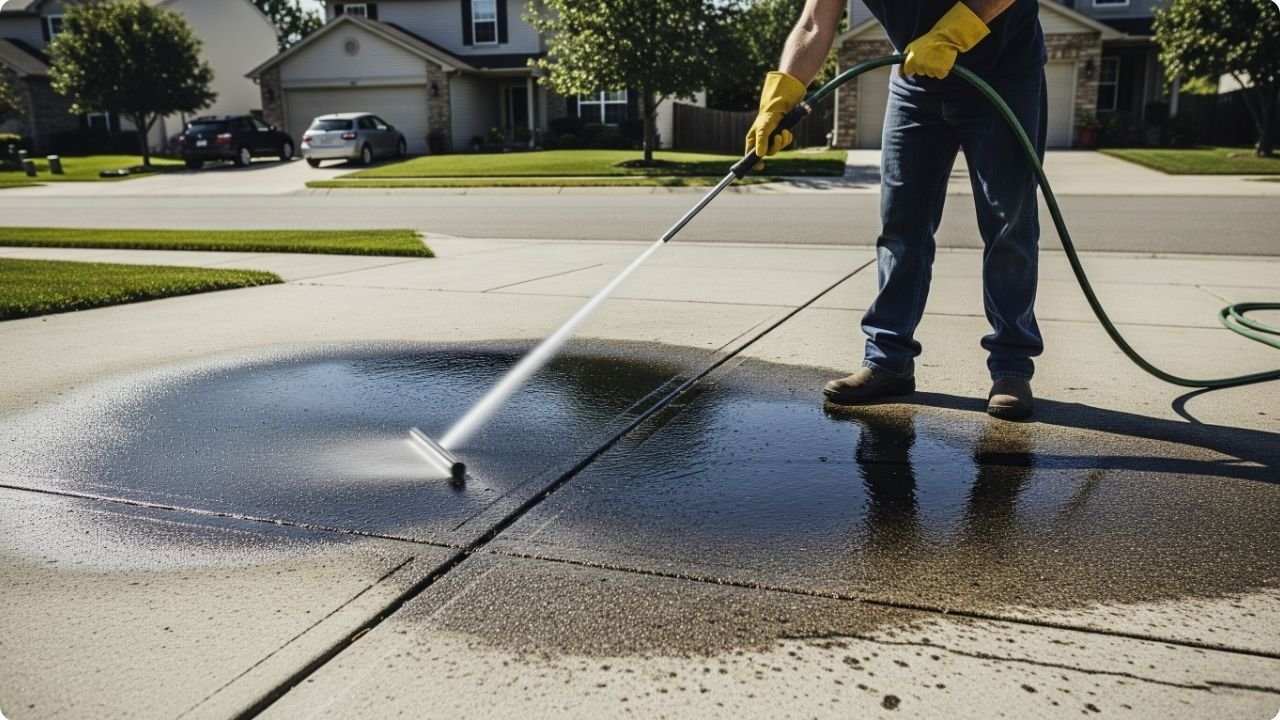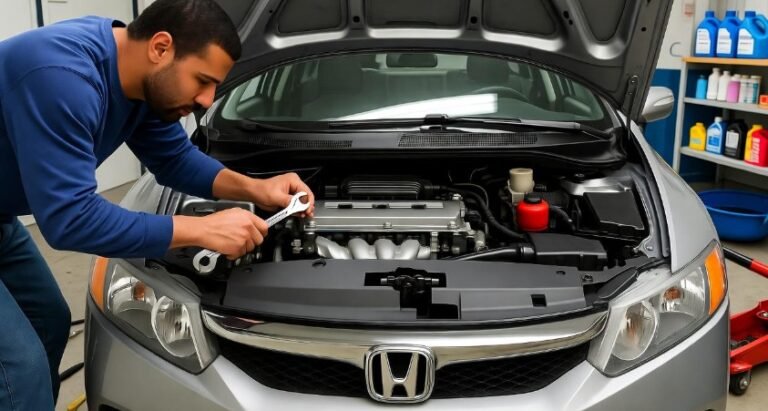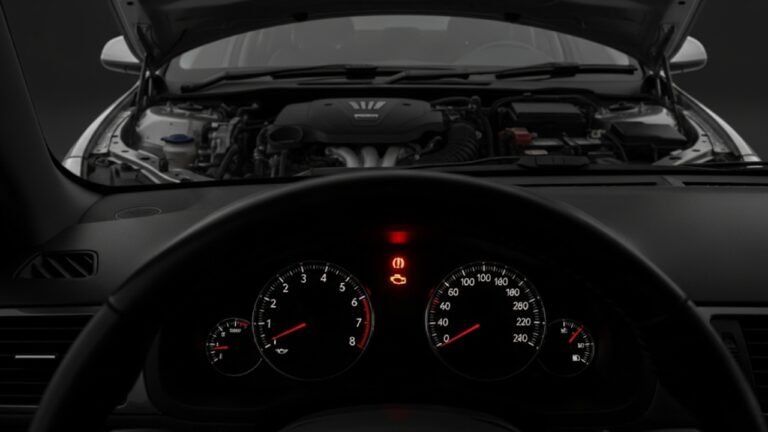How to Clean Car Oil Off Driveway: A Friendly Guide

It was a lazy Saturday afternoon when I noticed it. A dark blotch sitting right under my car. “Oh no, not again,” I mumbled. My driveway was once smooth and spotless. Now, it looked like it had lost a battle with an oil-slicked monster. If you’ve ever parked your car and noticed a grimy oil stain left behind, you’re not alone. These things are sneaky. One moment, your driveway’s clean. The next? It’s wearing a dirty tattoo of your car’s mischief.
That’s why learning how to clean car oil off driveway is more than just about aesthetics—it’s peace of mind. Oil stains don’t just look bad. They smell, they spread, and worst of all, they stay. But here’s the good news: You can remove them. Whether it’s fresh or old, with the right methods, tools, and a little elbow grease, you can win.
So, let’s get real. Forget complicated jargon or expensive tools. I’m here to break it down for you in the simplest way possible, just like I did when I tackled my own stained driveway.
Why Car Oil Stains Are So Stubborn (and What They Do)
Car oil isn’t like paint or soda. It’s thick, sticky, and designed to resist water and breakdown. Once it leaks onto your driveway—especially if it’s made of concrete—it starts to seep into the pores of the surface. Concrete is like a sponge. Tiny holes soak in the oil, locking it down like it’s been invited to stay forever.
Now imagine this happening day after day. One drop becomes a patch. That patch turns into a puddle. The longer it sits, the harder it gets to remove. Over time, oxidation kicks in, and the stain becomes a part of your driveway, changing the color and texture.
This is why cleaning car oil off driveway isn’t just about scrubbing the surface. You’ve got to lift the oil out, and sometimes, that means multiple steps. But trust me, it’s worth it.
Also, keep in mind, these stains aren’t just ugly—they’re slippery and can pose a hazard, especially when wet. And if you’re renting or plan to sell your home, it could hurt your curb appeal. So yeah, it’s a big deal.
The Fresh Spill Fix: Cleaning Oil While It’s Still Wet

Here’s what you’ll need:
-
Paper towels or rags
-
Baking soda or kitty litter
-
A stiff broom or brush
-
Dish soap (like Dawn)
-
Hot water
Steps to Follow:
-
Blot the Area First
Don’t rub. Just gently blot up as much oil as you can with paper towels. Rubbing spreads the stain. Imagine soaking up a spill on your favorite shirt—same idea. -
Absorb the Remaining Oil
Cover the spot with a generous amount of kitty litter or baking soda. Let it sit for 20-30 minutes. These materials pull the oil from the surface. -
Sweep It Away
Use a broom to remove the powder. You’ll likely see some of the stain lifted already. It feels like magic. -
Scrub It Down
Mix dish soap with hot water and pour it over the stain. Scrub with a stiff brush in circular motions. It’s like brushing away regrets—slow, but effective. -
Rinse and Repeat if Needed
Use a hose to rinse it off. If some stain remains, don’t worry—repeat the process. Sometimes it takes 2–3 rounds.
Bonus Tip: If you have powdered laundry detergent, it also works well in place of dish soap. Just sprinkle it, scrub with hot water, and rinse.
Battling Old, Set-In Oil Stains
Now, this is where the war begins. Old stains are stubborn. They’ve had time to settle in and bond with the concrete. But that doesn’t mean they’re invincible.
I once had a stain that sat for months—maybe longer. I tried everything from pressure washing to shouting at it (that part didn’t help). Eventually, I found a multi-step combo method that did the trick.
Tools You Might Need:
-
Degreaser (store-bought or homemade)
-
Trisodium phosphate (TSP) or baking soda
-
Scrub brush or push broom
-
Pressure washer (optional, but awesome)
-
Eye protection and gloves
Method That Works:
-
Degrease Deeply
Apply a concrete-safe degreaser and let it sit for 15 minutes. This breaks the oil’s grip. -
Add Powder Power
Sprinkle TSP or baking soda over the area while it’s still wet. It soaks up loosened oil and boosts your scrubbing power. -
Scrub Like You Mean It
Use a brush to attack the spot. Scrub in both circular and back-and-forth motions. Don’t be shy—old stains require muscle. -
Rinse or Power Wash
Hose it down thoroughly. If you have a pressure washer, now’s the time to use it. Nothing beats the feeling of blasting away grime. -
Repeat if Needed
Some deep stains need two or even three sessions. That’s okay. Each round gets it lighter.
Fresh vs. Old Oil Stains
| Feature | Fresh Oil Stain | Old Oil Stain |
|---|---|---|
| Best Removal Method | Blot, absorb, soap + hot water | Degreaser, scrubbing, pressure washing |
| Difficulty Level | Easy to Medium | Medium to Hard |
| Time Needed | 30 mins to 1 hour | 1–2 hours (may need repeats) |
| Tools Required | Paper towels, kitty litter, dish soap | Degreaser, scrub brush, TSP, power washer |
| Environmental Risk | Low | Medium (depending on degreaser used) |
| Chance of Full Removal | High if done quickly | Medium to High with multiple treatments |
This table gives you a quick side-by-side snapshot of what to expect when trying to clean car oil off driveway. It helps you plan, gather supplies, and set realistic expectations.
Eco-Friendly Ways to Clean Car Oil Off Driveway
Sometimes, harsh chemicals just aren’t an option. Maybe you have pets, or maybe you just care about the environment. The good news? You can go green and still clean effectively.
Try These Natural Cleaners:
-
White Vinegar + Baking Soda
This combo is a powerhouse for small, fresh stains. Pour vinegar over the area, sprinkle baking soda, and let the fizzing magic happen. -
Coca-Cola
Believe it or not, Coke can help with stains. Its acidity breaks down oil. Pour a can over the area, let it sit, then scrub and rinse. -
Cornstarch or Flour
These can act like kitty litter in a pinch. Just sprinkle generously over a fresh spill to absorb surface oil. -
Lemon Juice + Hot Water
Good for light stains. The citric acid cuts grease without harming plants or pets nearby.
Eco-methods might take a little more patience, but they’re safe and surprisingly effective.
When to Use a Pressure Washer (And How to Use It Safely)
If you’re like me, you might’ve been skeptical about using a pressure washer at first. I thought, “Won’t it just spread the mess around?” But once I tried it on a stubborn oil blotch, I became a believer.
A pressure washer can do what soap and scrubbing sometimes can’t—get into the pores of the concrete and blast the oil out.
What You Should Know:
-
Use a Degreaser First
Always pre-treat the area with a degreaser. The washer alone won’t lift deeply embedded oil. -
Choose the Right Nozzle
Use a 15° or 25° nozzle. Too narrow, and you risk damaging the driveway. Too wide, and it won’t clean deep. -
Keep It Moving
Never spray one spot too long. It can cause etching or leave clean “stripes.” -
Wear Safety Gear
Water jets at that pressure can hurt. Use gloves, boots, and eye protection.
After using a pressure washer, I could literally see the clean streak following my brush path. The satisfaction? Off the charts.
Preventing Oil Stains: Stop the Spill Before It Starts
You know the old saying: “An ounce of prevention is worth a pound of cure.” Well, when it comes to keeping your driveway clean, it’s 100% true. Once you finally manage to clean car oil off driveway, the last thing you want is a repeat performance next weekend.
Here’s how to stay ahead of the mess:
-
Use a Drip Tray
These are lifesavers. Slide one under your car if it tends to leak. They’re cheap and reusable. -
Check for Leaks Often
Look under your car every few days. If you see spots, it might be time to tighten a bolt or change a gasket. -
Park Strategically
If you’re unsure whether your car leaks, park on an old rug or cardboard until you’re certain. -
Get Regular Oil Checks
Prevention starts with a well-maintained vehicle. Regular oil changes reduce chances of surprise leaks. -
Seal Your Driveway
A sealed driveway is less porous, meaning oil can’t penetrate as deeply. It’s like applying sunscreen to concrete.
These small habits can save hours of cleaning and keep your driveway looking brand new.
Homemade Degreasers: Save Money, Stay Effective
You don’t always need store-bought stuff to fight a stubborn oil stain. Some of the best solutions are already sitting in your pantry or under your kitchen sink. I’ve tried a few of these myself, and they really surprised me.
My Top DIY Degreaser Recipes:
-
Baking Soda + Vinegar Paste
Mix baking soda with just enough vinegar to make a thick paste. Apply it to the stain and let it sit for 30 minutes before scrubbing. -
Dish Soap + Cornstarch
A mix of strong dish soap and cornstarch creates a creamy paste that cuts through oil when left on the stain for 20–30 minutes. -
Lemon Juice + Salt
The acidity of lemon and the grit of salt make this combo great for surface stains. Apply generously and let it sit in the sun before scrubbing. -
Hydrogen Peroxide + Baking Soda
This one works especially well for light-colored driveways. It fizzes and lifts oil while brightening the surface.
These methods don’t just clean—they’re gentle on the environment and your budget.
Common Mistakes to Avoid When Cleaning Oil Off Driveways
Sometimes, good intentions backfire. I’ve made a few mistakes myself that actually made the stain worse. Learn from me, and don’t fall into these traps:
-
Using Bleach
Bleach doesn’t dissolve oil. In fact, it can discolor your driveway and damage nearby grass or flowers. -
Skipping the Blotting Step
If you rub oil instead of blotting it first, you’ll push it deeper into the surface. Always soak it up before scrubbing. -
Using the Wrong Pressure Washer Nozzle
A too-narrow nozzle might damage the concrete. A too-wide one won’t be effective. Stick to 15°–25°. -
Letting Cleaners Sit Too Long
Some degreasers can eat away at your driveway if left too long. Always read labels and rinse on time. -
Working in Direct Sunlight
The sun can dry out your cleaner too quickly. Try working during cooler hours like morning or evening.
These small details make a big difference when trying to clean car oil off driveway the right way.
What To Do If Nothing Works: Calling in the Pros
Sometimes, despite your best efforts, a stain just won’t budge. That doesn’t mean you failed. Some older or deep oil stains are simply beyond DIY repair. When that happens, it might be time to call in professionals.
Professional Cleaning Services Offer:
-
Hot water pressure washing
-
Eco-friendly degreasing chemicals
-
Concrete resurfacing or sealing
-
Specialized tools for stain lifting
If your driveway is heavily stained or you’re preparing to sell your house, professional help can save you stress and time. I hired a local company once for a particularly stubborn stain near the garage—it cost a bit, but the results were flawless.
Plus, many services offer guarantees. That kind of peace of mind? Priceless.
FAQs: Quick Answers to Your Top Oil Stain Questions
1. Can I use WD-40 to clean oil stains from concrete?
Yes, WD-40 can break down oil on non-porous surfaces. Spray it, let it sit for 30 minutes, scrub, and rinse. It’s effective for smaller or newer stains.
2. Is pressure washing enough by itself?
Not always. While powerful, a pressure washer works best after applying a degreaser or soap to loosen the stain first.
3. Does cat litter really work?
Absolutely. Clay-based litter absorbs oil effectively. For best results, use it while the stain is still fresh.
4. How long does it take to fully remove an oil stain?
It depends on the age and depth. A fresh stain may take 30 minutes. An old one could take several treatments over a few days.
5. Will rain wash away oil stains?
Nope. In fact, rain can spread the stain and carry it to other parts of the driveway or lawn. It’s better to clean it before the next rainfall.
6. Can oil stains damage my driveway permanently?
If left untreated, yes. Deep oil stains can weaken the concrete, cause cracking, and leave permanent discoloration.
7. Are store-bought degreasers safe for plants?
Some are, some aren’t. Always check the label. If you’re worried, use eco-friendly options like vinegar or lemon juice instead.
8. Do I need to seal my driveway after cleaning?
It’s not required, but sealing helps prevent future stains and makes cleaning easier next time.
Final Thoughts: A Clean Driveway Is a Happy Driveway
There’s something truly satisfying about standing back and seeing a clean, smooth driveway where an oil blot once lived. It’s like removing a coffee stain from your favorite white shirt—you feel proud. Empowered. A little victorious.
Learning to clean car oil off driveway isn’t just a chore—it’s a skill. One that saves money, protects your home, and gives you control. Whether you’re using kitty litter and baking soda or going all in with a pressure washer, the key is simple: act fast, stay patient, and don’t be afraid to repeat the process.
I’ve had days when I thought the stain would never leave. But trust me—with the right tools and attitude, every stain has its weakness.
So go ahead—roll up those sleeves, grab your supplies, and reclaim your driveway.






